Abstract
Three-year-old children were tested on three categorization tasks of increasing levels of abstraction (used with adult baboons in an earlier study): the first was a conceptual categorization task (food vs toys), the second a perceptual matching task (same vs different objects), and the third a relational matching task in which the children had to sort pairs according to whether or not the two items belonged to the same or different categories. The children were tested using two different procedures, the first a replication of the procedure used with the baboons (pulling one rope for a category or a relationship between two objects, and another rope for the other category or relationship), the second a task based upon children’s prior experiences with sorting objects (putting in the same box objects belonging to the same category or a pair of objects exemplifying the same relation). The children were able to solve the first task (conceptual categorization) when tested with the sorting into boxes procedure, and the second task (perceptual matching) when tested with both procedures. The children were able to master the third task (relational matching) only when the rules were clearly explained to them, but not when they could only watch sorting examples. In fact, the relational matching task without explanation requires analogy abilities that do not seem to be fully developed at 3 years of age. The discrepancies in performances between children tested with the two procedures, with the task explained or not, and the discrepancies observed between children and baboons are discussed in relation to differences between species and/or problem-solving strategies.


Similar content being viewed by others
References
Bovet D, Vauclair J (1998) Functional categorization of objects and of their pictures in baboons (Papio anubis). Learn Motiv 29:309–322
Bovet D, Vauclair J (2000) Picture recognition in animals and in humans: a review. Behav Brain Res 109:143–165
Bovet D, Vauclair J (2001) Judgment of conceptual identity in monkeys. Psychon Bull Rev 8:470–475
Corrigan R, Schommer M (1984) Form versus function revisited: the role of social input and memory factors. Child Dev 55:1721–1726
Daehler MW, Lonardo R, Bukatko D (1979) Matching and equivalence judgments in very young children. Child Dev 50:170–179
Deloache JS, Pierroutsakaos SL, Uttal DH, Rosengren KS, Gottlieb A (1998) Grasping the nature of pictures. Psychol Sci 9:205–210
Evans PM, Smith LB (1988) The development of identity as a privileged relation in classification: when very similar is just not similar enough. Cogn Dev 3:265–284
Gelman SA, Markman EM (1987) Young children’s inductions from natural kinds: the role of categories and appearances. Child Dev 51:708–719
Goswami U, Brown AL (1990) Melting chocolate and melting snowmen: analogical reasoning and causal relations. Cognition 35:69–95
Goswami U, Leevers H, Pressley S, Wheelwright S (1998) Causal reasoning about pairs of relations and analogical reasoning in young children. Br J Dev Psychol 16:553–569
Greenfield DB, Scott MS (1986) Young children’s preference for complementary parts: evidence against a shift to a taxonomic preference. Dev Psychol 22:19–21
Herrnstein RJ (1990) Levels of stimulus control: a functional approach. Cognition 37:133–166
Kemler-Nelson DG (1999) Attention to functional properties in toddlers’ naming and problem-solving. Cogn Dev 14:77–100
Kemler-Nelson D, Russel R, Duke N, Jones K (2000) Two-year-olds will name artifacts by their functions. Child Dev 71:1271–1288
Lucariello J, Kyratzis A, Nelson K (1992) Taxonomic knowledge: what kind and when? Child Dev 63:978–998
Mandler JM (1997) Development of categorisation: perceptual and conceptual categories. In: Bremner G, Slater A, Butterworth G (eds) Infant development: recent advances. Psychology Press, Hove, pp 163–189
Oakes LM, Plumert JM, Lansik JM, Merryman JD (1996) Evidence for task-dependent categorization in infancy. Infant Behav Dev 19:425–440
Rosch E, Mervis CB, Gray W, Johnson D, Boyes-Braem P (1976) Basic objects in natural categories. Cogn Psychol 7:573–605
Ross GS (1980) Categorization in 1- and 2-year-olds. Dev Psychol 16:391–396
Savage-Rumbaugh ES, Rumbaugh DM, Smith ST, Lawson J (1980) Reference: the linguistic essential. Science 210:922–925
Smiley SS, Brown AL (1979) Conceptual preference for thematic or taxonomic relations: a nonmonotonic age trend from preschool to old age. J Exp Child Psychol 28:249–257
Smith LB (1983) Development of classification: the use of similarity and dimensional relations. J Exp Child Psychol 36:150–178
Thompson RKR (1995) Natural and relational concepts in animals. In: Roitblat H, Meyer JA (eds) Comparative approaches of cognitive sciences. MIT, Cambridge, pp 175–224
Thompson RKR, Oden DL, Boysen ST (1997) Language naive chimpanzees (Pan troglodytes) judge relations between relations in a conceptual matching-to-sample task. J Exp Psychol Anim Behav Process 23:31–43
Tomasello M, Call J (1997) Primate cognition. Oxford University Press, Oxford
Tomikawa SA, Dodd DH (1980) Early word meanings: perceptually or functionally based? Child Dev 51:1103–1109
Tyrrell DJ, Stauffer LB, Snowman LG (1991) Perception of abstract identity/difference relationships by infants. Infant Behav Dev 14:125–129
Acknowledgements
We are grateful to David Washburn, Julie Puttgen and Sarah-Jane Vick for their suggestions on how to improve the manuscript. Part of this study was carried out with a grant from the Lilly Foundation to the first author. The experiments comply with the current laws of France, where they were performed.
Author information
Authors and Affiliations
Corresponding author
Rights and permissions
About this article
Cite this article
Bovet, D., Vauclair, J. & Blaye, A. Categorization and abstraction abilities in 3-year-old children: a comparison with monkey data. Anim Cogn 8, 53–59 (2005). https://doi.org/10.1007/s10071-004-0226-y
Received:
Revised:
Accepted:
Published:
Issue Date:
DOI: https://doi.org/10.1007/s10071-004-0226-y




